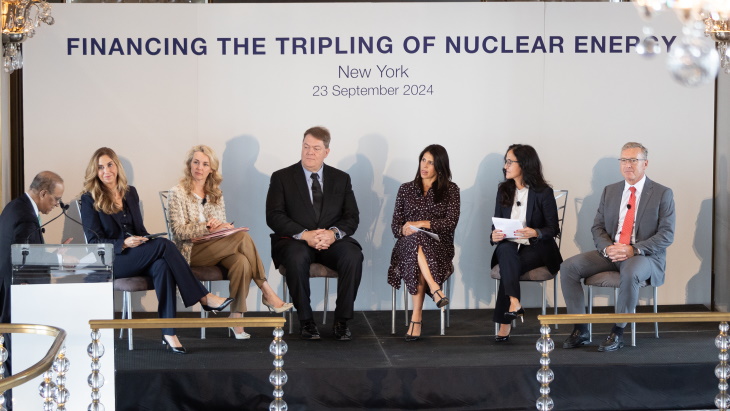New Jersey passes ZEC legislation
 New Jersey legislators yesterday passed bills establishing a zero emissions certificate programme that will recognise and compensate eligible nuclear power plants for their zero-carbon attributes and contribution to fuel diversity.
New Jersey legislators yesterday passed bills establishing a zero emissions certificate programme that will recognise and compensate eligible nuclear power plants for their zero-carbon attributes and contribution to fuel diversity.New Jersey legislators yesterday passed bills establishing a zero emissions certificate (ZEC) programme that will recognise and compensate eligible nuclear power plants for their zero-carbon attributes and contribution to fuel diversity.
 |
| PSEG supporters celebrate (Image: @PSEGNews) |
The New Jersey Senate passed bill S2313 by 28 votes to 9, with the Assembly passing its version of the bill, A3724, by 60 votes to 10. The bill directs the state's Board of Public Utilities (BPU) to issue the certificates, which represent the fuel diversity, air quality, and environmental attributes of one megawatt-hour of electricity generated by an eligible nuclear power plant which has been selected by the BPU to participate in the ZEC programme. To be eligible, a plant must, amongst other things, be licensed to operate until 2030 or later.
Four nuclear reactors - the single-unit Hope Creek and twin-unit Salem plants the single-unit Oyster Creek - together generate 38.5% of the New Jersey's electricity. Exelon's Oyster Creek, which is already scheduled to close this October following changes to state water use rules that would have required the construction of new cooling towers at the plant, will not be eligible for the ZEC programme.
The programme will be funded by a tariff of USD0.004 per kilowatt-hour imposed on retail distribution customers, with administrative costs to be covered, in part or in whole by application fees. According to estimates from the New Jersey Office of Legislative Services (OLS), the tariff is likely to generate a revenue of up to USD301 million. The Salem and Hope Creek plants would receive about USD253 million in revenue from ZEC sales to electric public utilities, the OLS estimates.
Warning on reactor shutdowns
Allowing nuclear power plants to close prematurely would set back US attempts to scale up zero-carbon power by years, according to a newly published memo from the Third Way think-tank. Because the lost capacity will likely be replaced by fossil fuels, premature nuclear closures will effectively mean that growth in zero-carbon renewables will be "wasted", the organisation said in a memo by Ryan Fitzpatrick, deputy director of its Clean Energy Program. "In 2015, nuclear facilities in the US alone generated as much zero-carbon electricity as all the wind turbines on the planet combined," it noted.
Public Service Enterprise Group (PSEG), which operates Hope Creek and Salem, has previously said that without intervention the plants would be unable to continue covering their costs within two years and may have to close. Last month PSEG, together with Salem's co-owner Exelon, suspended funding for future capital projects at the site because of the delays to the passage of the legislation.
Maria Korsnick, president and CEO of the Nuclear Energy Institute (NEI), said the New Jersey legislature deserved "immense credit" for recognising "in a timely fashion" the impact of the Salem and Hope Creek plants. "This is a remarkable moment for the people of New Jersey and for thousands of nuclear energy industry employees across the state," she said. She urged state governor Phil Murphy to "expeditiously sign this legislation into law".
The legislature also passed bills setting renewable energy goals. Under those bills - S2314 and A3723 - the BPU is amongst other things required to conduct an energy storage analysis, make changes to the solar renewable energy certificate programme, and establish energy efficiency programmes, and must work towards portfolio of 35% renewable energy by 2025 and 50% by 2030.
The states of New York and Illinois have already launched ZEC programmes, while Connecticut has passed legislation enabling the Millstone nuclear power plant to enter into a competitive procurement process alongside other zero-carbon energy sources. Korsnick called on policymakers in Ohio and Pennsylvania, which are also considering policies to support the continued operation of nuclear plants, to "follow suit and act expeditiously" to preserve their nuclear power plants.
Researched and written
by World Nuclear News










_88592.jpg)

